Whether you have pet pigeons and you want to breed them or you’re simply interested in knowing more about these common city-dwelling birds, understanding the pigeon’s life cycle can be both handy and interesting.
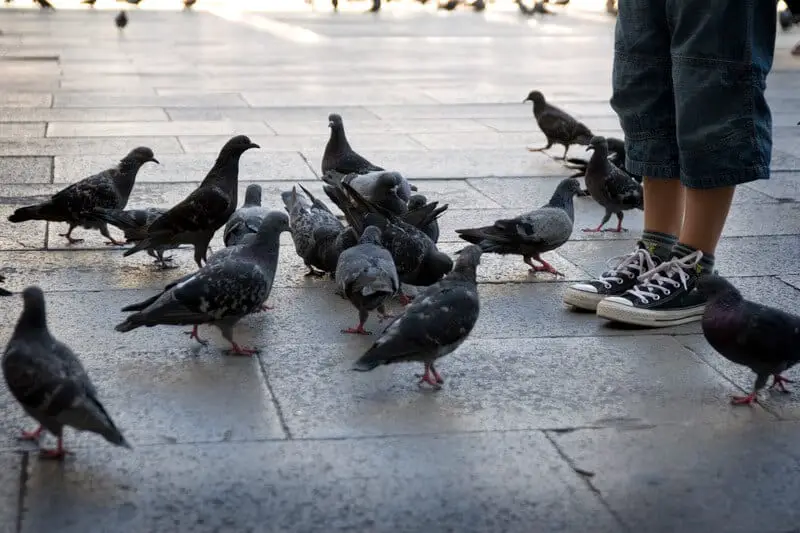
The mating and nesting habits of pigeons differ a bit from those of other bird species and you might be surprised at some of the differences.
Pigeons generally live in urban areas but can also be found on farms and rocky cliffs.
You’ll likely see a higher concentration of them in places where people are willing to feed the pigeons.
Pigeons also make great pets because they are quiet and mild-mannered and enjoy time to themselves as well as time interacting with humans.
Ready to find out more about the life cycle of a pigeon? Keep reading.
The Mating Habits of Pigeons
Before nesting and egg laying can occur, pigeons need to find a mate. Many pigeon pairs will mate for life unless they aren’t able to produce eggs. Then they may separate to find another mate.
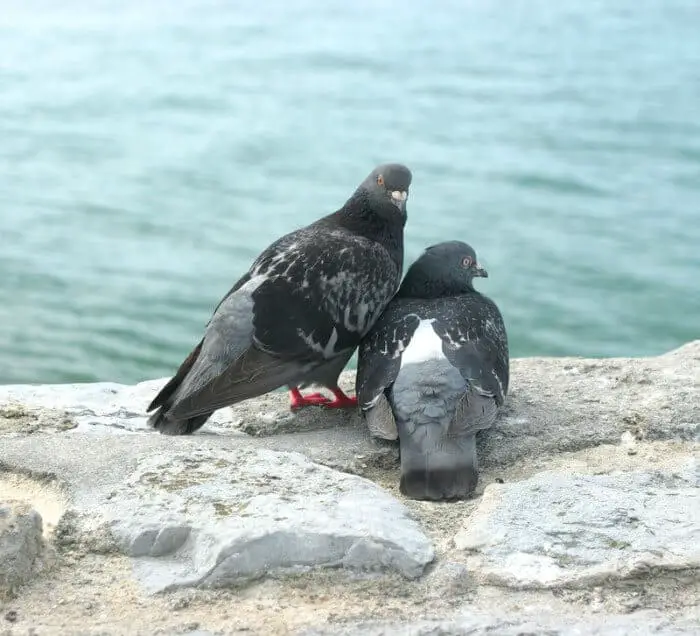
Males start the mating process by preening and strutting for the females.
Once a female shows interest, the pigeons will pair off and prepare to reproduce.
Other courtship behaviors include preening one another and regurgitating food to one another. When a male is ready to mate, he will jump on the female’s back.
Pigeons, especially those kept as pets, will breed all year round, but the fall and spring are when most reproduction tends to occur. In some cases, a pair of pigeons may produce more than one brood in a given year and in other instances, may create two nests and incubate two broods at one time.
Building the Pigeon’s Nest
Of utmost importance to a pair of pigeons who want to mate is the nest. This is where the eggs will be incubated and will offer protection for both the eggs and the parent pigeons as they wait for the babies to hatch.
When a male is ready to nest with a female, he will bring her a single branch, which will be used to start the nest. In the wild, pigeons make their nests under ledges or on flat rooftops.
In your home, you’ll want to provide your pet pigeons a safe place for their nest that somewhat mimics the wild.
It should be a place that’s cozy and that provides some privacy for the nesting parents.
To finish building the nest, the female will remain in the chosen location for the nest and the male will bring nesting materials such as straw, twigs and branches one at a time to build the nest with.
A pigeon nest isn’t generally as sturdy as other bird species’ nests because it’s not built in a tree.
However, unlike other birds, pigeons don’t remove the droppings from the babies and they reuse the nest several times, so over time, it turns into a sturdy, thick nest.
Researchers have even found that some parent pigeons use the eggshells and bodies of dead hatchlings to reinforce the nest over time.
Once the nest is completed, the female pigeon will stay in the nest, but won’t lay her eggs for several days.
Laying the Eggs
After the female has rested in the nest for a couple of days and mating has occurred, she will lay the first egg.
After about 44 hours, she will lay another egg.
Pigeon broods usually consist of two eggs but can be one to three total.
Younger females are more likely to lay just one egg and the presence of three eggs isn’t very common.
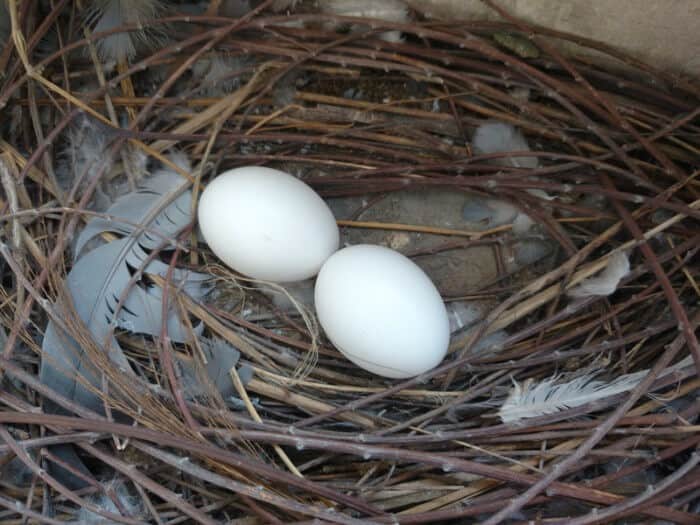
Most pigeon eggs are small and white, though they can vary in color a bit, depending on the environment.
For example, pigeons who nest in colder environments may lay eggs that are a little bit darker than average because this offers more warmth for the hatchling inside the egg.
Darker eggs also offer UV protection for eggs that are laid in sunny locations.
If you are breeding pigeons as pets, you will most likely see eggs that are white.
If, after mating, eggs don’t appear, you may want to consider having your pigeons try a new mate.
In some cases, barren pigeons can successfully reproduce with another partner if it’s not working with their current partner.
Remember, pigeons are generally monogamous and mate for life, so use caution when doing this.
Incubation Period for Pigeon’s Eggs
Once the female pigeon has laid her eggs, they will incubate for approximately 18 days before hatching.
This could be less and it could be more, but you can expect to wait just over two weeks before the babies begin to hatch.
Both the mother and father pigeon take a turn incubating the eggs. The mother pigeon usually sits on the eggs from late afternoon, overnight and into the mid-morning hours.
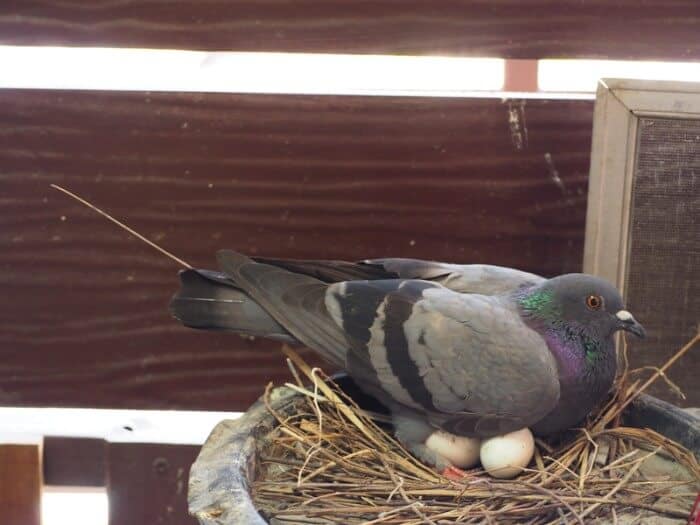
The father pigeon takes a turn from mid-morning to mid-afternoon before the female returns to take over.
During the time the male incubates the eggs, the mother pigeon rests and looks for food.
Incubation is important because by sitting on the eggs and keeping them warm, the parent pigeons are encouraging proper growth of the hatchlings and helping ensure their survival now and after hatching.
If you are breeding pigeons at home and notice that your parent pigeons aren’t properly incubating their eggs, you will need to step in. Call your veterinarian for advice with this.
The Hatching Process
On hatching day, the female pigeon stays in the nest around the clock and doesn’t leave to sleep or eat.
The amount of time it takes for the babies to hatch varies as does the time of day in which they begin to hatch.
If you breed pigeons more than once, you may start to notice a pattern for your pigeons and will be able to prepare yourself adequately for the next brood to be born.
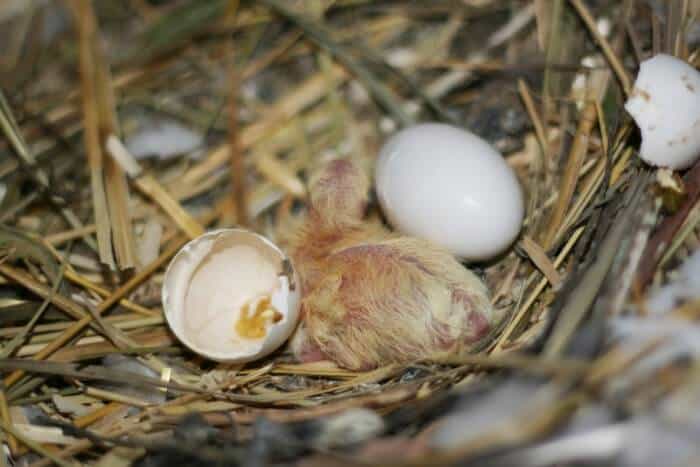
If your eggs don’t seem to be hatching properly or more than 18 days have gone by and the babies haven’t hatched yet, it’s a good idea to contact your veterinarian for advice.
The Pigeon’s Nesting Period
Unlike many bird species, a pigeon stays in the nest much longer.
Instead of about two weeks, the baby pigeons won’t leave the nest for close to a month, sometimes longer.
This is why people don’t often see baby pigeons.
By the time they are ready to leave the nest, baby pigeons look much closer to what an adult pigeon looks like.
When baby pigeons are first hatched, they are covered in a sparse down that’s usually white or yellow in color.
They are pretty helpless and rely on their mother and father pigeon for food as they grow.
Their feathers come in over the next couple of weeks and change color to mimic the grey color of a full-grown pigeon.
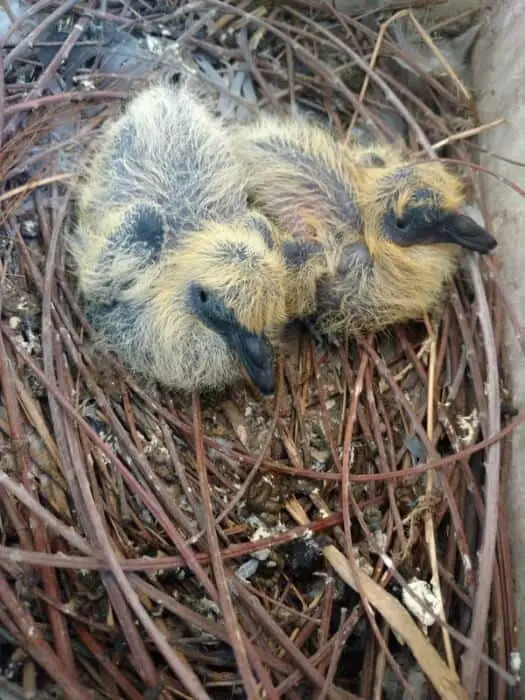
When they leave the nest, baby pigeons are nearly fully grown but may continue to develop their adult coloring for the next few weeks or months.
If your baby pigeons are born in spring or fall, you can expect this process to remain the same.
However, baby pigeons born in the winter may linger in the nest longer, up to 45 days.
This is likely because, without the added warmth of those other seasons, they take a little longer to grow and reach the ability to be able to survive away from the nest and independently.
Top Tip: If you ever find an abandoned baby pigeon and are wondering how old it is, use our pigeon age chart to work it out.
Feeding Baby Pigeons
Mother and father pigeons typically do a good job of caring for their baby pigeons.
Contrary to popular belief, baby birds don’t eat worms or seeds.
Instead, the parent pigeons will feed the babies crop milk, which is a partially digested mixture that they regurgitate from their crop directly into the crops of their babies.
Done correctly, you will not need to participate in this process at all.
However, if your parent pigeons aren’t properly caring for the babies and you need to step in, there are a couple of ways you can help.
You can feed the babies a special formula, which you can mix according to your veterinarian’s directions, using a small baby bottle or plastic syringe.
You can also try feeding the babies puppy biscuits soaked in water. Gradually thicken the mixture each day to ensure that the babies are getting adequate amounts of food, as well as the vitamins and minerals they need to grow and survive.
Never give a baby pigeon dairy because it can make them very sick.
Baby pigeons need to be warm when they eat or they aren’t able to properly digest their food.
For that reason, if you are hand feeding the baby pigeons, make sure they are well wrapped and warm before you begin feeding.
If this isn’t done correctly, you run the risk of killing the babies so use caution before feeding them.
If you don’t think they’re warm enough, wait to offer food until you’ve warmed them up.
Brooding Baby Pigeons
During the brooding period, you will see both the mother and the father pigeon feeding and caring for the hatchlings.
Both parents are able to produce crop milk and both will take a turn giving it to the babies.
You may notice that both parent pigeons are in the nest at once, but often it will be one or the other.
This gives one parent “time off” to rest and feed itself. This is important for ensuring that both the mother and father pigeon stay healthy and well enough to care for the babies.
Baby pigeons are often called squeakers, due to the sound they make.
You will notice your baby pigeons trying to hide in the corners of the nest as they are cautious by nature and their instinct is to hide from their natural predators.
Baby pigeons will begin flapping their wings in the nest but won’t try to fly away until the nesting period is over.
Pet Pigeons vs. Wild Pigeons
If you have pet pigeons, you may notice that their life cycle looks a bit different than a pigeon pair in the wild.
Because you are close by, you can assist with nesting, hatching and caring for the babies. However, in the wild, pigeons don’t have this help.
Your pet pigeon may be more willing to allow you to help raise the babies and many experts say that it’s ok to touch the pigeon eggs.
However, you want to take cues from your pet pigeon. If they seem distressed, see if you can figure out why or call the veterinarian.
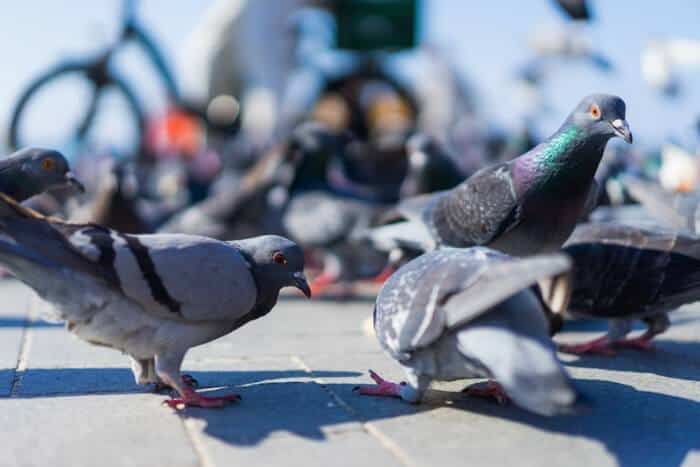
If your pet doesn’t seem to want you nearby, keep your distance and allow the pigeon parents to do the work.
Step in if you feel like you’re needed, but otherwise let nature take its course.
When it comes to wild pigeons, it’s best to stay away from their nests and their babies. Sometimes your presence can scare the pigeon parents and they may be too fearful to return to the nest and the babies could die.
Watch from a distance, but don’t get too close to a wild pigeon’s nest.
Fertile vs. Infertile Pigeon Eggs
Parent birds can be quite possessive when it comes to their eggs and may try to hatch eggs that aren’t fertile.
You can carefully check whether the eggs your pigeon has laid are fertile. Of course, you should only do this if your pet is amenable and is willing to allow it.
It’s easy to tell if your pigeon’s eggs are fertile and you are able to remove those that aren’t so that your pigeon doesn’t still try to hatch them.
Allow your pigeon parents to incubate the eggs for a couple of days. Then shine a bright light on the larger end of the egg.
If the egg is fertile, you will see a dark spot near the center of the egg, with some reddish veins extending from it.
If you only see a yellow yolk, the egg is not fertile and can be removed and disposed of.
You can repeat the lighting process several times to ensure that the baby pigeon is developing as it should. If the embryo has died, remove the egg from the nest and dispose of it.
Ensuring Healthy Pigeon Eggs
One of the best, and easiest, ways to ensure that your pigeon mother lays healthy and viable eggs is to ensure that she is fed a well-rounded and nutritious diet.
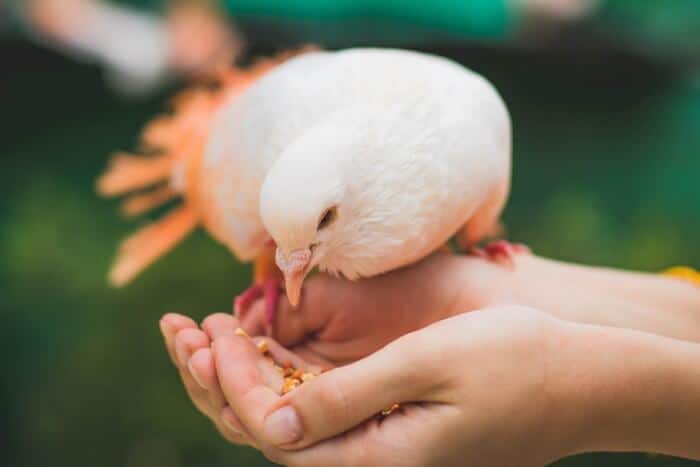
A primary part of her diet will be seeds and grains. Offering a wide variety of them means getting more vitamins and minerals in the appropriate amounts.
Pigeons also need a source of protein, such as snails or slugs.
You can also give your pet pigeon fresh fruits and vegetables but be sure they are small enough to prevent choking.
Never offer your pigeon avocado, as it can be toxic and make your pet bird very sick or even kill it.
When it comes to male pigeons, they also need a nutritious and well-rounded diet to ensure that they are healthy enough to mate and reproduce with the female.
In addition to the items listed above, you can also offer your pet pigeons a seed mixture designed for their needs or pigeon pellets, which contain most of the vitamins and minerals they need to thrive.
Work with your veterinarian to create a diet that’s ideal for your pigeon’s needs, throughout its life, as well as when it mates and reproduces.
Reaching Independence and Maturity
Most pigeon babies will reach independence at 4 to 6 weeks after hatching.
Keep in mind that pigeon pairs mate for life and remain monogamous to one another, which means that they may begin a new brood immediately after the previous one has left the nest.
Pigeons generally reach sexual maturity at about seven months after hatching.
However, most female pigeons won’t be ready to mate and lay eggs until she is about one year of age. Pigeons who lay eggs sooner than this may only produce one egg per brood.
If you are planning to breed your penguins, it’s a good idea to give them some time and allow them to reach a year old before getting started.
How Do I Know the Baby is Ready to Leave the Nest?
If you are breeding pigeons, it’s quite important to know when the hatchlings are ready to leave the nest.
Marking off the days is one way to do this, but time isn’t the only factor in a baby’s readiness to live independently.
Remember, a baby pigeon looks almost like an adult when it’s ready to fly the coop.
Pigeons vary in size, but you’ll notice that they are similar to the parent pigeons when it’s time to leave the nest.
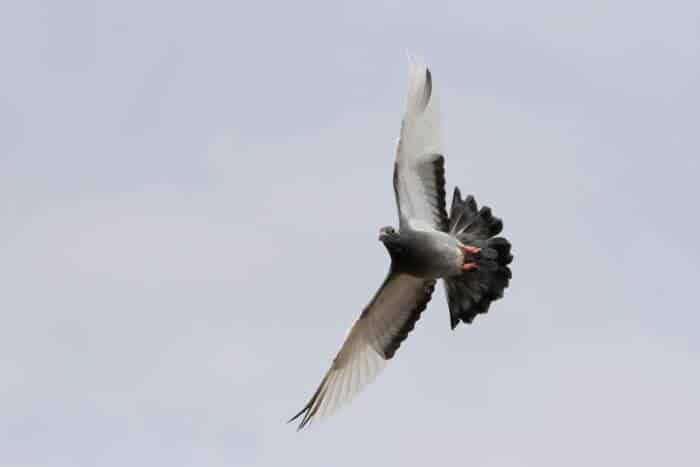
Pigeons can range from about 5 to 15 inches and weigh about 1 pound to just over 5 pounds, though babies will still be on the smaller side when they get ready to fly away.
Take all things into consideration when you determine if the babies are ready to leave. Their size, their appearance and their willingness to fly on their own should all play a role in their departure.
If you are worried that a bird might not be quite ready, but the parent pigeons are encouraging it, talk to your veterinarian about how you can step in and help.
The Lifespan of a Pigeon
Now that your baby pigeons are ready to go, you can expect them to follow in their parents’ footsteps.
They’ll begin to show an interest in mating at around the 7 to 12-month mark and will find their life mate and begin to create broods of their own.
The average lifespan of a wild pigeon is about three to six years, though some may live to be as much as ten years old.
However, pigeons who live as pets can live as long as 15 years, though it’s very uncommon. The length of a pigeon’s life depends on its diet, how good it is at protecting itself and avoiding predators and how well cared for it is.
That means that you can create a nice long life for your pigeon by feeding it a healthy diet, breeding it properly and giving it plenty of love and attention.
Fun Facts About Pigeons
Here’s a lot of stuff to know about the life cycle of a pigeon but understanding them on another level is a great way to become more familiar with pigeons and how they live their lives.
It’s also fun to learn more about them, especially if you keep them as pets or want to breed them.
Check out these fun facts about a pigeon’s life:
● Pigeons can navigate back to their nest from distances as far away as 1,300 miles
● One reason why pigeons may make such good pets is that they comprehend space and time (like humans), but using different brain processes
● Research shows that pigeons may be able to detect cancer
● The fastest pigeon on record reached an impressive 98 miles per hour during a race
● The world’s most expensive pigeon ever sold cost $1,900,000
As you can see, there’s more to a pigeon than simply mating and reproducing.
Pigeons are exceptionally intelligent creatures and are said to have saved many lives during WW1 when they carried messages across enemy lines.
Pigeons get a bad rap for being a pest, but if you give them a chance, you might find that you enjoy their company and love raising their babies at home.
